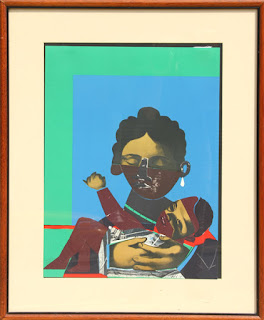Romare Bearden’s prints have a visual flow with his more well-known collages. Printmaking was one of many art media the artist pursued during his long career, but something special happens with his prints, (and I admit, I may be a bit biased toward the medium). They have either the flat rich color of the Caribbean, a place he lived for a period of time, or they have a fluid, juicy look as though someone is playing around with watercolor and a brush. Sometimes the textures found in his work are rich and woven, like fabric.
Other times the combination of his textures and seeing a person’s eyes popping out of the composition speak about sadness, pain and endurance. In any case, the work weaves a patchwork of experience that is uniquely his own, talking about a group of Americans whose choice to come to this country was forced upon them, but who rose and persevered to become some of the greatest artists, musicians and writers of the 20th century. Bearden can easily be one of those notable African-American artists, but his work tells a visual story about the Af-Am struggle, from the deep south, to the creative freedom found in the north. His work uses photographic collages of faces, African-American faces, and cuts them into shards, shreds their individuality and melds them together, creating one African American. One people. One experience.
That’s a hard thing to do, to speak about a race of people whose dignity as human beings were stripped bare and their ancestry torn from their memories. How does one show that horror, and instinctual human effort to survive adversity? Bearden does it by not covering up the situation or making it palatable. He shows the collaged body parts and efforts to do normal things anyone would do, but he shows them cut up, glued back together in a hodgepodge. Not really a clear identity of them as a person, but a collective of them as a race, and group. Strength woven through their brokenness.
Bearden goes where no other artist would have gone before him. Certainly, many artists have felt liberated to speak their own truths because of his stance. My God, he was brave. It could likely have been the strong mother figure he was raised by who instilled a strong sense of self on Bearden, but also his own personal experiences during WWII helped shape his ideas about art and identity. I, for one, see the message through the media; how printmaking helped him extend his work, his calling. Young artists working today have a good role model and teacher in the Af-Am fusion prints of Romare Bearden.
BIO
Romare Bearden (1911 –1988) was an American artist who depicted African-American life, mainly through collage. Born in Charlotte, North Carolina, his family moved to New York City when he was a child. His mother, Bessye Bearden, was politically active in New York City's Board of Education, and the Colored Women's Democratic League. The Bearden household was also a meeting place for major artists and writers of the Harlem Renaissance.
Bearden went to Lincoln University and Boston University before transferring to New York University, where he graduated in 1935. He continued his artistic studies under George Grosz at the Art Students League in 1936 and 1937. While in New York, Bearden went to work in Bob Blackburn’s printmaking studio. He learned about printmaking there and continued to pursue various print mediums throughout his career. He served in the Army during WWII, from 1942-1945. Then in 1950, he went to study Art History at the Sorbonne, in Paris.
In 1954, he married a dancer, Nanette Bearden, who later became an artist and a critic.
In 1956, Bearden began studying Chinese calligraphy. His early work focused on unity and cooperation within the African-American southern community, and his style was strongly influenced by muralists Diego Rivera and José Clemente Orozco. He briefly experimented with abstraction, but began to make collages in the 1960s. He took his imagery from daily rituals of African-Americans’ southern rural life and their northern urban life, combining these experiences with his own. He felt collage was able to combine abstraction with real images of people from different cultures so one could understand something of the African-American experience.
Bearden was a founding member of the The Spiral, a Harlem-based art group formed to discuss the African-American artist’s struggle for civil rights. It was during the 1960s civil rights movement that Bearden's work became more representational and more socially conscious. For him, collage presented a direct connection with African Americans’ rights which were always shifting, and society itself was in a state of constant change. Bearden wanted to show how nothing is set in stone, and the image will always change.
Romare Bearden died in 1988, in New York City. The Romare Bearden Foundation was established two years after his death "to preserve and perpetuate the legacy of this preeminent American artist."
Awards
1987 National Medal of Arts
1978 National Academy of Design
1972 National Institute of Arts and Letters
1966 American Academy of Arts and Letters









Thanks so much for sharing all this!
ReplyDeleteI am a collage instructor/artist and YOU have enlightened me!